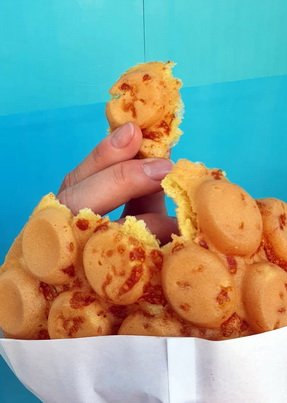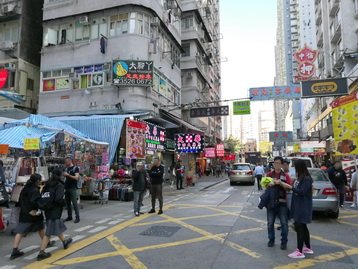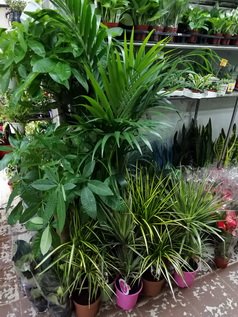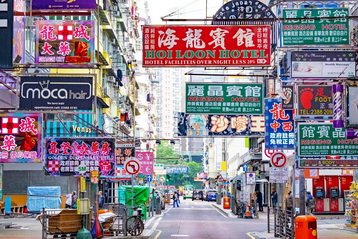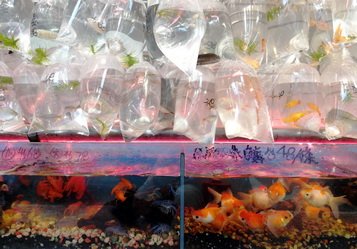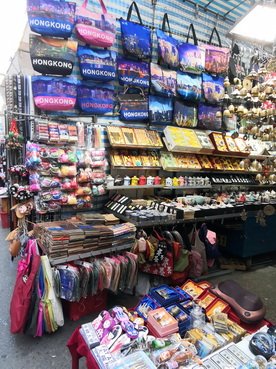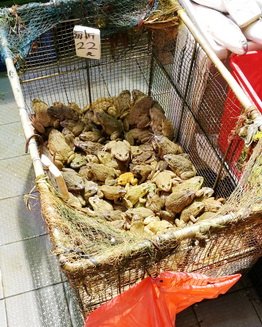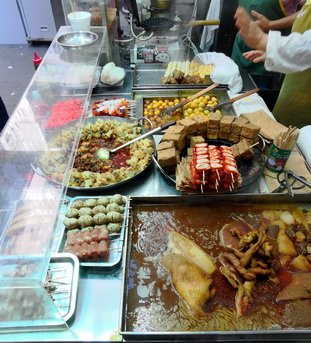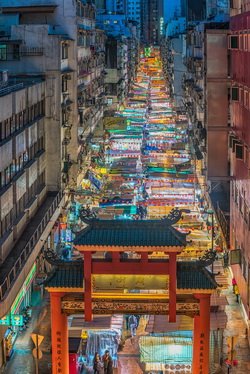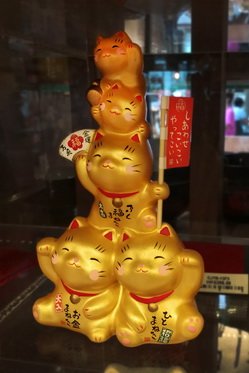markets of kowloon
Markets, wet markets, street markets…
1 Sham Shui Po area (flea market, Toy Street, etc.) – 2 Mong Kok – Flower market – Bird Market – 3 Where to next, south??? – Goldfish market – Ladies Market – Jade Market – 4 Temple Street/night market – Foreword
Hong Kong of today has its own special culture that grew up in “the yesterday”. When the British came in the XIX century, only on Hong Kong Island, were 16 small villages. And each of them had its own market – for food, other things, and services. Whether on the street, in the shop, or on a boat – people traded all sorts of products, talking about the day and family in the meantime, especially with friends.
Time passed. While in the western world the villages changed into cities and street markets into a specific place it wasn’t what happened in Hong Kong.
Hong Kong is different. It grew rapidly and the multitude of people created a void, never to be fulfilled. Galleries, streets full of shops, and street markets of every king can be found everywhere. Each district, maybe a village of old, has to have its own. It this forever warm and humid city, threatening with rains in some periods, the vicinity of a local market is precious.
And so we, tourists, have a separate world to discover. Familiar shops with unfamiliar products and strange culture, rarely seen nowadays in the West. So looking for a perfect souvenir, have fun hassling. Observe the people around you – eating where they work, even while you are buying; not noticing you at all or trying to sell something too heavily, sleeping in a corner, playing cards or mah-jong, doing homework with children…
But where to go, and what to buy…
Sham Shui Po MTR area (not on the map)
The region deserves a point of its own. There are not many tourist places to visit there, and everyone just passes it, riding on the red metro line.
But the locals come here to buy everything they would need. There is also plenty of people working along the main street here, in the government buildings or other offices. It is something where the Cantonese people go – so why don’t you give it a try?
If you take the A or C exits from the metro station you will find yourself on the side, where you will find some flee markets and electrical appliances shops.
On the other hand, if you take B or D exits you will be on the side with the street market, computer center, and “toy street”. Scattered around will be the electrical appliances shops as well – to put it short – you have everything you need in a house here.
The flea market is full of curiosities. Some people literally, take what they have at home, and come here to trade. There are books, porcelain, some useful used home things, and others – that look like house heirlooms. You never know what will be here, but it makes a unique souvenir if you find something that will be of interest to you.
The street market on the other side of the metro station is a typical Cantonese thing. It is full of things used by locals in their everyday life and bought by tourists – because they look “chinese”. Clothes for you and plenty for the babies and children – to start with. If you ever wanted to buy a superhero costume – look no further. Bed linen, pillows, curtains… suitcases, telephone covers, cables of all usages… bracelets, amulets, necklaces, things for hair – usually very glittering, linked with red string (for good luck) or made of different stones (sometimes even from jade)… food and bites next to vegetable and fish vendors… seasonal stuff – making the streets all red and gold close to the Chinese New Year date…
Computer Centre is something to remember because it is a way, they like to do things here. Yes – you do have shop “lines” in Hong Kong (Broadway, Fortress, etc.). But small shops thrive in Hong Kong. Computer Centre is usually a place where you can buy all sorts of electric and electronic things, including tons of videogames. Usually, the building has at least 2 floors filled with small vendors. It is better to look for something specific because the display leaves a lot to wish for. There is just too much of everything there, but you cannot aver your gaze, it is too fascinating. On top of everything – there are repair booths here as well. Perfect -everything in one place!
“Toy street” – this cryptic name describes a part of Fuk Wing Street. As its nickname states – you will find toys there. All sorts of toys and games, of old and today, of international heroes and Chinese ones, shops with Lego and some other “no-name” building blocks. Things to the bathroom, lake, sea, home, garden, park, etc. Yet again – there are more than 2 dozen shops here, so keep your child close. There is usually a lot of people here and it would be easy for the small ones to get lost (photo above).
If you decide to go to Monk Kok on foot – it would be around a 20-30-minute walk for you. I recommend going through the “exit A/C” part. On your way, you will encounter a district wholly designed to house textile-related shops. Tissues, needles, threads, buttons, and people able to sew you a dress/suit in a few days.
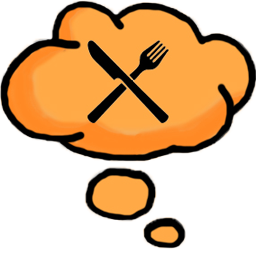 You also should be able to pass by a stand with egg-waffles. A treat is a form of popular, sweet fast food in Hong Kong. It comes in a plain version that we all know and love, but in this particular shop, you can find egg-waffles with chocolate, cheese, made with purple potatoes and other curiosities. Check it out – More Egettes at 17 Yu Chau Street (photo above; close to Prince Edward, exit D).
You also should be able to pass by a stand with egg-waffles. A treat is a form of popular, sweet fast food in Hong Kong. It comes in a plain version that we all know and love, but in this particular shop, you can find egg-waffles with chocolate, cheese, made with purple potatoes and other curiosities. Check it out – More Egettes at 17 Yu Chau Street (photo above; close to Prince Edward, exit D).
Mong Kok
Arriving close to the Prince Edwards MTR you will find yourselves in Monk Kok. These are its northern parts and following Nathan Road south will guide you to Victoria Harbour and the depths of Kowloon.
In older times the villages were all around the local hills here – filled with ferns and agriculture spaces of the Hakka settlements. This is what the original Chinese name was about – a place filled with ferns. The heart of the developing district was further south and was growing rapidly with the coming of the British. Closer to the mountains there was peace and quiet. Foreigners used these terrains to hunt for tigers.
Although some Chinese characters have been changed and the name Mong Kok stands for a prosperous corner now. The first markets on this list are peaceful, but it is guaranteed to change.
Flower Market
Getting closer to Flower Market Street you are entering the other world. The grey of the surrounding buildings is replaced with green and colors of different shapes and sizes. Your sense of smell is overwhelmed with a mixture of flower and herb smells.
Locals love this place for the bargains they can find here and the abundance of everything needed for planting a home garden. The exteriors of the shops are filled with the main product – flowers, trees, ferns, ficus, and mini palm trees, dracaenas, etc. But when you venture inside there will be sacks of soil, fertilizers, pots, and so on. There are pot flowers, cut flowers, and flower compositions. And close to the Chinese New Year, there is also plenty of red and gold here. It is an old tradition to buy some flowers at this time of the year, so it will bring with them prosperity and good luck (the colors and golden gourds/balls ornaments are a part of it).
It is a nice experience to just catch a glimpse of this place. Maybe on your way to another market (below), that is close by.
Bird Market
Do you remember in some old western movies about Chinese history… there were always some caged birds somewhere. Somebody was feeding or playing with them giving you a 10-minute scene with some wisdom carrying dialog.
There was once a tradition to keep songbirds at home. In small, wooden cages were a little fellow was singing to everyone’s content. Today you see less and less of it since people have less time for pets. Bird lovers meet in their favorite places – like parks, where they take their companion, hang it on a predesignated hook, and chat with friends (a rare treat to see it, but when you do see some caged birds in a park – don’t be surprised).
The bird market is another place for them to meet. This makes it more difficult to distinguish which bird is for sale and which is a pet, but it makes the atmosphere there very friendly and adorable. For a tourist – just this multitude of animals will be attractive. Not talking about birds only, because you can find their food there as well. The stalls are filled with cages for the insects – from small ones to the quite big grasshoppers. It is both disgusting (the author of the article being a woman) and fascinating, you will love it.
 There will be plenty of street food on your way, but there is a good place for dim sum in the area. It is a line of restaurants called One Dim Sum, here in Mong Kok on Tung Choi Street. Food is at a reasonable price and delicious when it goes to the most favorite Chinese dumplings. If they still have it – try the mango rolls dessert (it is to die for). Bring cash with you – at the time of writing this article, they do not accept cards.
There will be plenty of street food on your way, but there is a good place for dim sum in the area. It is a line of restaurants called One Dim Sum, here in Mong Kok on Tung Choi Street. Food is at a reasonable price and delicious when it goes to the most favorite Chinese dumplings. If they still have it – try the mango rolls dessert (it is to die for). Bring cash with you – at the time of writing this article, they do not accept cards.
Where the next steps?
The new name for Mong Kok means “a prosperous corner” and it is more than accurate. Going south you will venture into the world of shops of every kind. The place was filmed in many movies. Showing you crowded scenes of the day and neon ones of the night. Often it was the Triad kingdom, where bars and restaurants were just next to the nightclubs, casinos and massage and more parlors.
All is still here (not too sure about the mafia though). The first thing you see are shops, but between them and on the side, alleys are bars and restaurants. If you look close enough you will find hostels, rooms for rent – and many of them rented by the hour. There are hidden top floor cafes. You will also notice massage places and something spicier.
Take it all in following the markets, or just wander around. The next steps lead along Fa Yuen or Tung Choi streets. The first one will lead you deeper to the south being the street marketplace. The second one will finish quickly, and the aquarium theme will be changed to something else.
Goldfish Market
The length of Tung Choi Street is heaven for fish lovers. Goldfish and turtles are known to bring good luck in China, so it is understandable, why this is the main product sold here.
Apart from it, you will also encounter puppies, kittens, and rabbits. Shops here are the main supplier of pet-related products. You can find bargains but also some horrendous prices. Whether you saw or asked in the Bird Market – regular songbird costs around 2000 HKD. But when it goes to the furry friends – try adding one more zero to it. Pets are a luxury item in Hong Kong – both desired and a source of problems. But for many, having a pet is a form of socializing and/or a baby substitute. But this is Hong Kong – the money and the space people live in here dictates what they can do and cannot do (not to mention the fashion. Yes! For many, making a cute selfie with a pet is quite important).
Ladies Market
Fa Yuen Street that is starting close to Prince Edward MTR will introduce you to the Ladies Market first (it is very close to the Flower Market). This is a place where a woman could spend a whole day looking for “something” or 30 minutes if it is something specific. It is a true paradise with a lot of bargains and a lot of things to choose from. Mong Kong has a lot of brand shops, but here you just find a piece of cloth to wear – nothing special. But this is just perfect for those who look for it.
In Hong Kong, you have this special way people are dressed in. It is so because of the climate and fashion… ¾ trousers are just better in the periods when it rains a lot. The Cantonese women like to wear miniskirts and short jeans with a loose blouse as well. It just works better in this weather. Apart from that, you will also see a lot of European fashion styles – from Paris, the US – you name it.
In the Ladies Market, you will find all sorts of different things to wear and a lot of accessories. In between the stalls, you will find some phone accessories or household things sellers. There will be some bag on the display mixed with food stalls. And behind all of it – places to grab a bite. These will be the everyday restaurants the hard-working people go to – you can try them as well.
Or you can see how a wet market looks like. At the junction of Fu Yuen Street and Mong Kok Road, there is a grey, seemingly not worthy of notice, building. Inside there are stalls filled with fruits and seafood. The fish swim in the tanks, the shrimps try to escape the frogs play their songs. And on the top floor – a treat – a kitchen, where you can eat something fast and cheap. You can even buy some seafood at the fresh market and ask the cook to prepare it for you. You will pay a little extra, but at least you will know what you eat.
Fu Yean Street turns into the “sneaker/shoes street” somewhere around here (4a). You will see it clearly at the junction with Argyle Street. No matter which brand you look for you will probably see it here. The signs give the names as Puma or Adidas, but inside the stores you can find all variety of shoes.
If you would follow Argyle street to the West, you would find Mong Kok MTR. Try it, whilst looking at the side roads. Firstly, you will find more stalls on the street – this is the continuation of the Ladies Market. It goes south for another few hundred meters. The next side street is full of small shops with cosmetics, electronics, and other products. The main road is filled with brand shops, jewelry, etc. If you cross it – there will be even more shops on the other side including Decathlon and Langham Place (4b; with its own “beauty alley” inside – it is like cosmetics heaven).
Keep an eye on the restaurants and small eateries with delicious products: buns, dim sums, sweets, freshly squeezed juices, 20 different teas, etc. There is even a cat café close by at Sai Yeung Choi Street – it is called Café de Kitten (5 minutes south from Monk Kok MTR). You would have to go up a few floors and pay a bit more for the entrance, but the furry company will make it worth your while. If you are a fan of these places there are more: OnDogDog Café not far from where you are or Rabbit Land in Causeway Bay on HK Island.
The market street finishes with a hospital. By then you are really close to Yau Ma Tei MTR. Try exploring adjacent streets for other products. There are many shopping galleries here, and some computer centers as well.
Jade Market
Not far from Yau Ma Tei MTR is a Jade Market. Hong Kong and Taiwan are still the most popular providers of jade. Although it is quite difficult to buy the original one. Not only its price is quite high, but with the existence of artificial jade, you can find yourself cheated.
It is a popular product among treasure seekers and tourists looking for a souvenir. Jewelry and statues in green color are not only pleasant for the eye. For Chinese people, they are a magnet for good luck, fortune, and good health.
Fortunately, the Jade Market is full of stalls selling trinkets made out of artificial jade (it is made of glass) – they do not cheat, the price is relatively low, and you can still bargain a little bit. You can get a Buddha figurine at a reasonable price unless you want a true thing. But there are some serious sellers around there too.
So how to spot the real jade?
Firstly – do your research. There are different varieties of jade, which demand different prices. As with anything you buy for a higher price – you would want to know what the types and the prices are. Internet and jewelry stores will come to your help. Don’t believe that the price is sooo good. It is not – if someone tells you it is original, but it is too cheap, that means it is a fake. Secondly – jade is a hard stone that cannot be scratched. Try to run your fingernail on it and see what happens. It is also heavier than the artificial one – but this requires some practice. A second opinion or a certificate would be nice too – but sometimes you do not have time for it. Also – avoid the Chinese festivals, especially New Year – prices are at its top then.
Lastly – artificial jade is not that bad either. If you are happy with your choice and the seller is sincere about the things he sells – why not buy something as beautiful, but cheaper.
Temple Street Market
A few steps to the south from the jade stalls and you will find the famous night market of Hong Kong. It is not that different from the Ladies Market. You can find all the typical street products there – clothes, bags, leather products, souvenirs, etc.
The thing that makes it special is that it is open till the late hours of the night. When every other market is starting to close for the evening – this one is buzzing with people. The official hours are 6 – 11 pm but are sometimes longer. Just watch out for public transport. Metro stops running at 1 am.
It is already dark or will be dark soon. Streets change their character, lit by colorful lights. Somewhere between the stalls, there is a fortune teller that with a toss of a few coins will predict your future… It is a good place to observe local life since most of Hong Kongers have time to go out in the evening.
The food is great here as well. Behind the stalls are some restaurants, but there are also typical Chinese stall restaurants – dai pai tong. Here, they specialize in seafood, which you can even see swimming in the tanks. Pictures are a nice addition too – and they make ordering food this much easier. Try the side alleys and streets as well. There are more food vendors there – Temple Street is sufficiently overcrowded. There is a real nice xiao chi vendor there – it is at the corner of Ning Po and Woosung Street (at the time of writing this article it is called Taste Pavillon).
If you think about doing the markets in one day I strongly recommend otherwise.
On the other hand – why not. But there should be a car following you, to put all these bags in! Too much to carry around.
It is better to mix the markets with other things that you will do. Sample it, as you would sample the Cantonese food. Compare the prices, don’t be too hasty, go where your eyes lead you… and they will because there will be a lot of exciting places around you.
On this note I propose to you 3 visits: a quick one to the “toy street” and to check out the local flavors; a walking tour from Prince Edward MTR to Monk Kok MTR – it is a nice chunk full of possibilities; an evening visit to Jade Market and Temple Street followed by some evening fun.
Also, remember – that the markets start to operate from about 11-12 AM. If you are planning a morning visit – stop. You will only find empty stalls.
What’s more – during the week, before 5-6 PM, they tend to be less busy.



